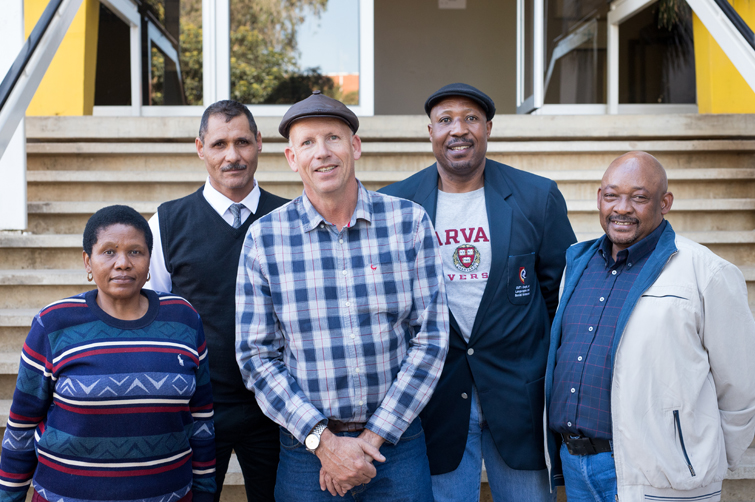Latest News Archive
Please select Category, Year, and then Month to display items
13 January 2020
|
Story Eugene Seegers
|
Photo Anja Aucamp
 Spearheading the digital expansion of the conversational Sesotho course is IDEAS Lab Director, Johann Möller (middle). With him are from the left: Prof Pule Phindane, CUT; Dr Brenton Fredericks, CUT; Bahedile Letlala, UFS Department of African Languages; and Dr Elias Malete, UFS Department of African Languages.
Spearheading the digital expansion of the conversational Sesotho course is IDEAS Lab Director, Johann Möller (middle). With him are from the left: Prof Pule Phindane, CUT; Dr Brenton Fredericks, CUT; Bahedile Letlala, UFS Department of African Languages; and Dr Elias Malete, UFS Department of African Languages.
For many years now, the UFS has been offering a one-year course in conversational Sesotho for staff members; this can then be followed up with the one-year course in advanced conversational Sesotho. The conversational Sesotho for students in the Faculty of Education was introduced in 2018 at the UFS.
The Central University of Technology (CUT) needed a conversational course for its first-year students and approached the Department of African Languages for the development of such a course. Living as we do in a multilingual country; this additional language skill opens doors and often hearts as well.
Using instructional design principles
However, the need was identified by both CUT and UFS to present this crucial information in a way that would be more appealing to digital natives as well as to those less familiar with technology. The Department of African Languages on the UFS Bloemfontein Campus, together with relevant departments from the CUT, approached the IDEAS Lab located on the UFS South Campus, since they already have a reputation for being a specialist on broadcasting and repackaging curricular content for digital presentations. The IDEAS Lab provided technical advice and built the multimedia programme, which will help the user to hear and practice phrases in Sesotho, using instructional design principles. The course will be available to both staff and students belonging to the two universities.
Room for growth
Johann Möller, Director of the IDEAS Lab, says this pilot programme will give both institutions the opportunity to test the use of multimedia for language acquisition. He adds, “Language is extremely complex, and we would like to expand this learning aid in the future.” In fact, the original design has room for growth built into it.
To keep things simple for the user and the building team, it was decided to start out with only four potential everyday scenarios where a staff member would like to speak Sesotho: Firstly, how to greet other persons from different genders; secondly, potential scenarios one might encounter in the university environment itself; thirdly, how to deal with situations at a hospital; and finally, how to use one’s language skills at a filling station.
Pronunciation is key
Each scenario contains three to four conversations that the learner can revise, along with images and audio that illustrate the situation and assist with correct pronunciation. The system does not allow the user to progress unless they have listened to the pronunciations of the sample sentences or phrases.
Further reading material and vocabulary lists are also provided, with the result that people who are using the programme can learn at their own pace. The authoring software Articulate Storyline was used to build the individual scenarios and each conversation or lesson within it. The lessons are also not dependent on an internet connection; they can be downloaded onto a flash memory drive and used offline.
Kovsie's netball players triumph
2009-07-24
 |
| The Free State U-19 team that won the 2009 SA’s tournament that was held in Mafikeng. |
 |
In action are Danique du Toit (left) and Mioné Steinman of the Free State U-19 team against the Western Province. They also won the 2009 SA’s tournament that was held in Mafikeng.
Photos: Markus Steinman |
The University of the Free State’s (UFS) first netball team brought the silver medal home this year after they ended second in the University Sport South Africa (USSA) Tournament that was held in Johannesburg. According to Ms Burta de Kock from KovsieSport at the UFS and coach of the team, the team suffered somewhat due to injuries and the fact that eight of their players were newcomers.
In spite of these challenges, six of the UFS players were included in the USSA team. They are Carine Terblanche, Shirolene Smith, Lienke Perold, Anuschka Greeff, Karla Mostert and Anja Zandberg. Karin Venter, also from KovsieSport at the UFS, was appointed as coach of the SA Universities Team.
Kovsie’s netball players also recently played for the Free State U-19 team in a tournament in Mafikeng. The entire team consisted of Kovsies. They won the gold medal by winning all their matches against other regions and provinces. Four of the Kovsie players were also included in the South African U-19 group. They are Karla Mostert, Mione Steinman, Cleopatra Kgoputso and Anuschka Greeff. Anuschka was named as the best goal shooter during the tournament.
The entire Free State U-21 team, which brought home the silver medal after they had lost to Gauteng in the final match, also consisted of Kovsie netball players. Six of these players were included in the South African U-21 team. They are Anja Opperman, Anja Zandberg, Poppie Thethele, Rika Stevenson, Nadia Nieuwoudt and Iselma Parkin. Iselma Parkin was also named the best defender of the tournament and Poppie Thethele the best centre player. |